Growing Broccoli Organically
|
© Steve Masley…Click IMAGE to Enlarge |
Growing broccoli (Brassica spp.) is easy, if you plant it at the right time, and make sure it has steady, regular water.
There are some soil tweaks and pests to watch out for, but broccoli is as easy to grow as other cruciferous vegetables.
Home-grown broccoli can be harvested at the peak of freshness, and prepared moments after cutting it from the plant.
|
© Steve Masley…Click IMAGE to Enlarge |
It’s sweet, tender, and cooks in a fraction of the time it takes to cook broccoli that has been sitting in produce coolers for days or weeks, or shipped cross-country.
After harvest, most broccoli varieties produce a second crop of small side-shoots that can be harvested 2-3 weeks after the main head.
|
Almost as Large as Regular Broccoli Heads © Steve Masley...Click IMAGE to Enlarge |
The tender broccoli leaves near the top of the plant can also be steamed or braised like kale after you harvest the side shoots.
Home gardeners interested in growing broccoli should look for seed blends of multiple broccoli varieties.
Broccoli varieties head up at different times, and having multiple varieties will spread the harvest over a few weeks, instead of everything coming in at once.
Broccoli Varieties
|
Growing Broccoli in Containers
Harvesting Broccoli
How to Grow Broccoli
|
Growing Broccoli |
|---|
|
|
|
|
|
|
|
|
|
|
|
|
|
|
|
|
|
|
Broccoli has the same growth pattern as other fall vegetables. Broccoli grows best under cool, wet conditions.
As long as conditions remain good, it will continue to store nutrients in leaves and stalks. Hot, dry weather will cause it to head up prematurely, producing small, inferior heads.
The secret to growing good broccoli is to keep it moist, and keep it cool until the plant is large enough to produce a good head.
Broccoli Cold Tolerance/Season
|
Steve Masley…Click IMAGE to Enlarge |
Broccoli and other cruciferous vegetables have good frost tolerance as seedlings, and greater frost tolerance as mature plants. When growing broccoli and other cruciferous vegetables, the sugar content rises in response to freezing temperatures (sugar acts as anti-freeze in plants).
I’ve seen mature broccoli plants wilt and freeze solid, then thaw out a couple days later and bounce back, sweeter than ever.
Sow broccoli seeds outdoors as soon as the ground can be worked in spring, or start seedlings indoors under lights a month before your last frost date and set out as seedlings (after hardening off for a few days) around the time of your last frost date. See Planting Broccoli below for planting depth and spacing.
If you’re growing broccoli in a long-summer area, plant in early spring and again in early August, to get a crop that matures in October or November.
|
|
Garden Preparation for Planting Broccoli
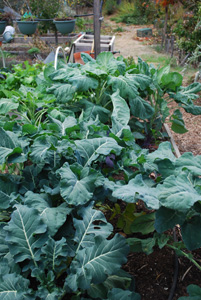
|
|
© Steve Masley…Click IMAGE to Enlarge |
Broccoli is a heavy feeder, and performs best with a deep root zone in soil with ample organic matter.
When growing Broccoli, prepare the soil to a depth of 12-20” (30-51cm). Lay down a 2-3” (5-8 cm) layer of good garden compost or composted manure when you prepare the soil.
Broccoli and other cruciferous vegetables grow best in soil with a slightly acidic to slightly alkaline pH, pH 6.8-7.4. See Changing Soil pH for tips on adjusting soil pH.
If your soil is lean or you’re short on compost, you can amend the soil with a good organic fertilizer like Dr. Earth Organic Tomato, Vegetable, and Herb Fertilizer
, and mix it into the soil before planting.
This is a balanced (5-7-3) blend of fish meal and alfalfa meal for early-season growth, feather meal for mid- to- late-season growth, soft rock phosphate and fish bone meal for phosphorous, and kelp meal for potassium and boosting plant immunity.
For information on organic nitrogen fertilizers that work in the cool season, see Cool-Season Organic Nitrogen Sources.
Broccoli also benefits from supplemental calcium in the soil. Add ground oyster shell or dried, crushed eggshells and mix into the soil at the time of planting. See Organic Calcium Sources for more information.
Planting Broccoli
Broccoli seedlings should have succulent stems and large, green leaves. Seedlings with hard stems or purplish, stunted leaves have been too long in small pots and will produce tiny broccoli heads.
Broccoli Plant Spacing
|
© Steve Masley…Click IMAGE to Enlarge |
In fertile soil, broccoli plants can spread 2-3’ across, by 2’ high.
If you’re growing broccoli in a single-dug bed (soil prepared to a depth of 10”—25 cm), set plants out 15-18” (38-46 cm) apart, in rows 18-24” (46-61 cm) apart.
If you’re growing broccoli in a raised garden or double-dug bed (soil prepared to a depth of 18-24”—46-61 cm), set plants out 18-20” (46-51 cm) apart, in rows 18-24” (46-61 cm) apart.
With most vegetables, deep soil preparation allows you to tighten spacing between plants, but with broccoli and other cruciferous vegetables, the plants grow larger and need a little more space when planted in a deep, fertile soil.
Care and Feeding of Broccoli
Watering

Growing Broccoli requires regular, steady water, 1-1 ½” (2.5-3.8cm) per week. This is especially important during hot, dry weather.
Overhead watering in hot weather can drop the temperature around the plants 10° F (6°C), due to evaporation. This is great for young plants, but should be avoided once heads start forming, to reduce the risk of soft rots setting into the crowns.
When you’re growing broccoli, mulching is critical. A 1” (2.5 cm) layer of mulch keeps the soil surface much cooler, and reduces surface crusting and the threat of bolting significantly.
Fertilizing Broccoli
Broccoli is a heavy feeder, so even if you build organic soil amendments into the soil when you plant, it may need a side-dressing of compost, composted manure, or a good organic fertilizer like Dr. Earth Organic Tomato, Vegetable, and Herb Fertilizer at mid-season, before they start heading up.
Broccoli Plant Care
Watch for signs of pest or disease problems early in the season, and intervene quickly to prevent more severe problems later in the season. Flea beetles and imported cabbage butterfly larvae can wreak havoc on small seedlings. See Broccoli Pests for control measures.
Once the plants are growing vigorously, watering is the most important task when growing broccoli.
Broccoli Pests
Broccoli shares the same pests as other cruciferous vegetables—cabbage, cauliflower, Brussel’s sprouts, kale, collards, rutabegga’s, and radishes. Asian greens like tatsoi, pac choi, komatsuna, gai-lon, mizuna, and mustard are also susceptible to the same insect pests, but to a lesser extent.
Imported cabbage butterflies, cabbage root maggots, flea beetles, cutworms, slugs, and snails are the primary pests of broccoli and other cruciferous vegetables.
Plant vigor is the first and best defense against insect pests. Plants stressed by overcrowding, inadequate water, or poor soil give off stress chemicals that insect pests home in on. Robust, healthy plants don’t give off these chemicals. They mount vigorous chemical defenses when attacked by pests, and still have enough energy to produce high yields.
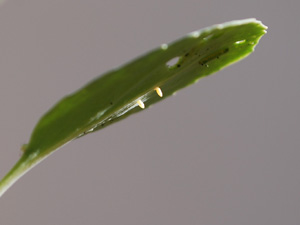
|
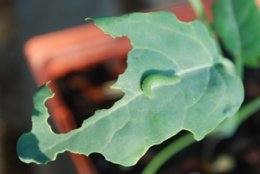
|
Imported cabbage butterflies are the biggest pests of broccoli and other brassicas. These are the small white butterflies you often see fluttering around fields in the spring and early fall. They have a wingspan of 1½-2” (3.8-5 cm), and may have a black mark near the tip of each wing.
They lay their eggs singly on the undersides of leaves, and the eggs hatch into tiny green caterpillars that immediately begin munching holes in leaves. In the photo at left, there are two eggs near the center. Just above them, the dark line is a larva that hatched recently.
Tiny holes in the middle of a leaf are often the first sign of their presence. As the larvae become larger—like the one on the right—they chew larger holes and destroy more leaves.
Prevention is the best control for imported cabbage butterflies. As soon as you see adults fluttering around your garden, assume your broccoli plants already have eggs on their leaves. Check for holes, and if you see any, look on the bottom of the leaves near the midribs for small, green caterpillars. They’ll be hard to see, so look carefully.
Eggs are single, oblong, and cream-colored, about 1/16” (1 mm) long. If you see any, smear them over the bottom of the leaf with a finger.
Dr. Earth Final Stop is a ready-to-use organic garden insect killer that’s a combination of essential oils of rosemary, sesame oil, peppermint, thyme, cinnamon, and garlic. Controls aphids, whiteflies, mites, caterpillars, earwigs, sowbugs, beetles, scale, spiders, ants, leafhoppers, mealy bugs, pilbugs, crickets and other insects. It can be used on edible vegetables up to the day of harvest. It is not persistent, like chemical insecticides, so repeat applications may be necessary to control heavy infestations.
Floating row covers can prevent infestations of imported cabbage butterflies, flea beetles, and cabbage root maggots by denying adults access to the leaves or soil to deposit their eggs. Sunlight, rain, and air can pass through, but not insect pests. If you’ve had problems growing broccoli because of these pests, floating row covers are a good solution.
Cabbage Root Maggots are the larvae of flies. They attack the roots, weakening the plant, reducing yields, and making it more susceptible to other pests and diseases. Their chewing also exposes wounded roots to soil pathogens, opening the way for infection.
Flea Beetles are tiny beetles that chew holes in leaves. If the leaves have a shotgun-blast pattern of holes, flea beetles are the likely culprits. They can be devastating for broccoli seedlings.
Cutworms can be a problem for young seedlings near grasslands, or in gardens recently cleared from grasses. You’ll know they’re around because a few seedlings will disappear at random (if multiple seedlings in a row are gone, rabbits or rodents are the likely culprits).
Cutworms are easy to control with cardboard collars. The insulated cardboard rings from coffee cups are perfect for this. Or a 3” (7.5 cm) wide strip of cardboard, rolled into a cylinder 2” (5 cm) in diameter, and taped. Simply place it around the stem of the plant, and press it into the soil about 1” (2.5 cm).
Wood ashes scattered around the plants can deter Snails and Slugs, but they have to be re-applied after rain. I’ve never had any luck with the old beer-and-saucer trick.
Sluggo is the best snail and slug solution I’ve found. It’s an iron phosphate bait that’s pet and animal-safe, and acceptable for use in organic gardening. Slugs and snails eat it, stop eating seedlings, and die soon after.
Apply Sluggo to the soil as soon as snails and slugs start proliferating in the spring. Be sure to apply it away from your vegetables, since it attracts snails and slugs.
See Companion Plants for planting strategies to reduce broccoli pest problems.
Broccoli Diseases
I’ve seen very few diseases growing broccoli organically in home gardens and small-scale production. Bacterial Soft Rot is the only common broccoli disease I’ve encountered. Sections of the head darken, go soft, and begin to collapse.
is the only common broccoli disease I’ve encountered. Sections of the head darken, go soft, and begin to collapse.
The disease is more common under warm, wet conditions, and with broccoli varieties that have flat heads. Varieties with dome-shaped heads (e.g., ‘Arcadia’, ‘Marathon’, and ‘Shogun’) are more resistant.
Other broccoli diseases common to large-scale field production include Black Rot, Club Root, and Fusarium Yellows.
Most broccoli diseases enter plants through injured tissues, so garden practices that limit injuries to plants and organic pest control measures that reduce damage by chewing insects can go a long way toward preventing the spread of diseases.
Cornell’s Vegetable MD Online has a series of articles on broccoli diseases , complete with photos. Click Here
, complete with photos. Click Here for Cornell’s list of disease-resistant broccoli
for Cornell’s list of disease-resistant broccoli .
.
Companion Plants for Growing Broccoli
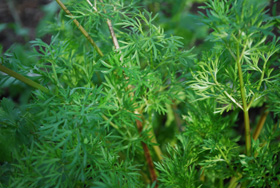
|
|
Ladybugs Love© Steve Masley …Click IMAGE to Enlarge |
Dill, fennel, and cilantro are good companion plants when growing broccoli. Plant them in borders around the edges of the patch, or interplant them between broccoli plants.
Lacy, feathery foliage attracts lady bird beetles, lacewings, and other insect predators. If you allow them to flower, their flowers attract and sustain tiny, gnat-sized parasitic wasps that lay eggs in aphids and the eggs and larvae of pests like Imported Cabbage Butterflies.
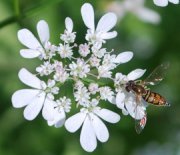
|
|
Cilantro (Coriander) © Photo by Steve Masley …Click IMAGE to Enlarge |
I like to plant short-term Asian greens like tatsoi, pac choi, or mizuna between longer-season broccoli plants. I harvest some, but leave others to flower. The flowers attract aphid predators like lady bird beetles, syrphid flies, and parasitic wasps.
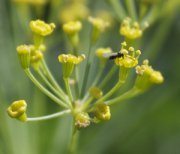
|
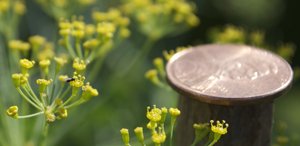
|
|
|
For more information, see Attracting Beneficial Insects.
Top of How to Grow Broccoli Section
Growing Broccoli in Containers
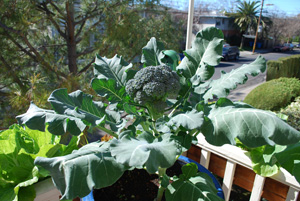
|
|
© Steve Masley…Click IMAGE to Enlarge |
Broccoli takes well to container culture, it’s one of the easiest winter vegetables to grow in pots.
If you’re growing Broccoli in containers, you’ll need a rich potting soil and a deep planter box or a large (5-7 gallon) pot for best results. Broccoli is a heavy feeder, and does best in potting mix with a lot of organic matter. Worm castings or compost are great.
When growing broccoli in containers, it’s usually best to build organic soil amendments into the potting mix before you plant.
Use a good, balanced organic fertilizer like Dr. Earth Organic Tomato, Vegetable, and Herb Fertilizer, 4-Pound Bag
.
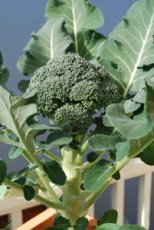
|
|
in Containers© Steve Masley Click IMAGE to Enlarge |
If you have access to a worm bin, add ½-gallon of fresh worm castings, including worms. The worms inoculate the potting mix with beneficial bacteria and fungi, and convert organic soil amendments into plant-available form for your vegetables.
For information on organic soil amendments, see the NPK Fertilizer page.
See Growing Vegetables in Containers for more information on vegetable container gardening.
Copyright © 2009-2020, by Steve Masley, Grow-it-Organically.com
All rights reserved
HOME | About Us | Contact Us | Privacy
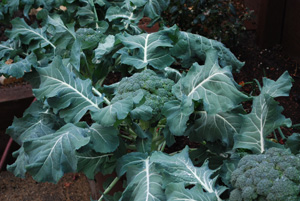

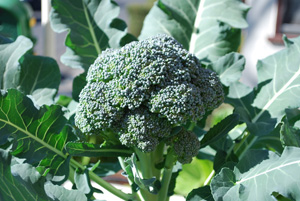
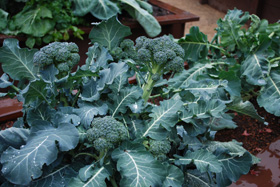
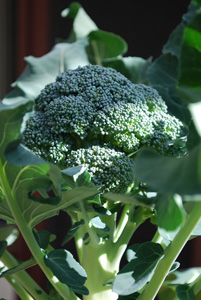
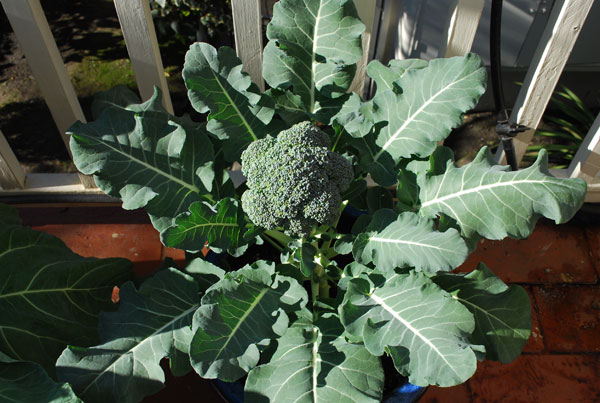
New! Comments
Have a question or comment about what you just read? Leave me a comment in the box below.